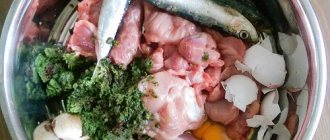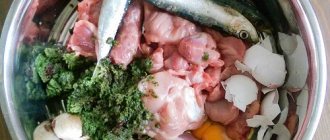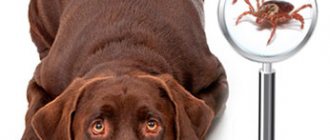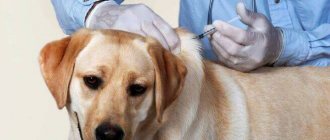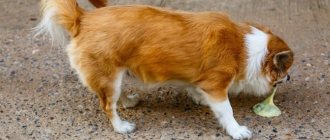Vomiting is a protective reflex of the body that allows you to quickly get rid of the contents of the stomach. The urge often occurs after eating. After eating, a dog may vomit undigested food due to physiological and pathological disorders. In the first case, there is no health hazard. Physiological causes are often associated with feeding errors. Pathological disorders can pose a serious threat to the pet's body. The presence of accompanying symptoms helps determine the danger of a situation. The frequency of attacks and the characteristics of the vomit are also taken into account. Neglected cases sometimes lead to death. Therefore, if your dog experiences regular bouts of nausea, you should immediately visit a veterinarian.
Causes of vomiting in dogs
It was noted that the reasons are divided into two large groups. Vomiting is provoked by natural factors and pathological ones caused by various diseases.
Physiological reasons
Their important difference is their one-time use. After vomiting, the pet quickly recovers and becomes active. There are no associated symptoms. There is nothing to indicate the condition is dangerous. Among the natural reasons that cause vomiting are:
- motion sickness This can happen to dogs in cars and other vehicles. The condition occurs due to a weak vestibular system. To prevent attacks, it is enough to give your dog anti-motion sickness tablets. They are prescribed by a doctor. You should not select the drug yourself;
- hunger. With long breaks between meals, excess gastric juice begins to accumulate in the animal’s stomach. The body strives to get rid of it, so vomiting occurs;
- stressful state. This could be moving, having a new pet nearby, etc.;
- weather. Heat can make you feel nauseous;
- grass. It is rich in fiber, which allows it to coat the stomach. This helps rid the body of harmful substances and pieces of fur;
- binge eating. The stomach strives to get rid of excess food entering it. This problem is often encountered by pets who do not feel full while eating;
- change of diet. This applies to situations where dietary changes occur abruptly rather than gradually. And if you plan to adjust your diet, you need to do it smoothly and under the supervision of a nutritionist;
- toxicosis. Pregnant animals also suffer from this condition. Mild nausea without deterioration in well-being in this case should not cause concern;
- low quality food. Expired foods and bad food can cause vomiting. Dogs especially love to dig through the trash can. It is important to isolate the animal from it;
- characteristics of the body. This reason includes situations when other natural factors are excluded, and the pet feels well.
Physiological sources are easy to recognize. If after an attack the dog feels well, is active, and no longer vomits, then the causes are natural.
Pathological factors
They are indicated by multiple repetitions of vomiting attacks with accompanying symptoms such as loss of appetite, gastrointestinal upset, apathy, and fever. This condition can be provoked by various pathologies, including the presence of parasites in the body, intestinal obstruction, acute infectious diseases, and traumatic brain injuries. Nausea also occurs with the following ailments:
- internal bleeding;
- problems in the urinary system, such as kidney failure;
- foreign object entering the stomach;
- gastrointestinal pathologies, including ulcers, gastritis;
- poisoning;
- oncological disease.
The described conditions cannot be ignored. If vomiting occurs repeatedly, or your pet feels unwell after an attack, you should seek help from a veterinary clinic.
Contact your veterinarian immediately
This list of causes of vomiting with dry food is far from exhaustive. It can be a sign of many chronic and infectious diseases that require medical intervention. We strongly recommend that you immediately contact a veterinary clinic if:
- the dog vomited repeatedly, not only from dry food, but also from any other food or water;
- the animal strives to find a secluded place, does not want to play or go for a walk;
- body temperature is elevated or significantly below normal (37.5–39°C).
Delay in such situations can cost the pet’s life, since dehydration with uncontrollable vomiting occurs very quickly, especially in puppies.
When there are no other symptoms, but the dog regularly vomits dry food, consulting a specialist will also not be superfluous. Perhaps your pet suffers from some chronic disease, identifying which at an early stage can significantly improve the prognosis and get rid of unpleasant symptoms.
Diagnosis by a veterinarian: when to contact
To prescribe effective treatment, your pet will need to undergo an examination. It is needed if attacks are repeated, the animal exhibits accompanying symptoms, and the vomit has an unusual color. You need to take a closer look at the color of the foam when your dog is vomiting:
- A white tint indicates the presence of a foreign object in the stomach. This type of foam also occurs when your pet is sick due to the heat.
- Green vomit indicates the presence of parasites in the body.
- Yellow foam is characteristic of pathologies associated with the gallbladder and liver.
- Red color indicates internal bleeding. This is the most dangerous condition in which the animal needs urgent help.
It is necessary to prepare for the diagnosis. The dog owner should take a small amount of vomit as a sample. This will simplify and speed up the diagnosis.
It is necessary to know the approximate time of the first attack and how many times it was repeated in the future. All other symptoms of illness are recorded. The owner should inform the doctor about any recent changes in the dog's life. For example, food changed, permanent place of residence changed, other animals appeared. Do not feed your pet until you see the veterinarian. You need to give him some water if the attacks have stopped.
To alleviate your pet's condition, it is recommended to lay it on its side and open its mouth. In this situation, you need to take the animal to the doctor. You should not give your dog any medications unless prescribed by a veterinarian.
To make an accurate diagnosis, a blood test, ultrasound, and gastroscopy are performed. If a state of acute dehydration is detected, the animal may be admitted to the hospital. The rest of the therapy depends on the causes of nausea.
Additionally, the following studies may be required:
- general urine analysis;
- taking a sample of vomit. This will identify a parasitic disease;
- blood chemistry. To identify various disorders in the functioning of the body.
To promptly detect problems in the abdominal cavity and intestinal obstruction, radiography is performed.
Popular questions and answers
veterinarian Reshat Kurtmalaev about why vomiting occurs and what to do in such cases
Is vomiting in a dog always a sign of a serious illness?
Vomiting is not always critical. The fact is that the animal can simply overeat. Owners usually love their pets and begin to feed them heavily. Most often this happens in the case of dry food, which swells in the stomach and begins to look for ways to somehow get out.
How often can a dog vomit normally?
Up to 5 times a month is considered normal for an animal. Because they may have some kind of stress, anxiety, they may overeat, so if vomiting does not occur more often, there is no need to sound the alarm.
Can a dog, like cats, vomit its own hair?
Some of them, especially representatives of long-haired breeds, like to eat their own wool.
They tear it off and swallow it. Most often this happens due to stress. Sources
- Chernenok V.V., Simonova L.N., Simonov Yu.I. Clinical and hematological aspects of canine gastroenteritis // Bulletin of the Bryansk State Agricultural Academy, 2022, https://cyberleninka.ru/article/n/kliniko-gematologicheskie-aspekty-gastroenterita-sobak
- Belyaeva A.S., Savinov V.A., Kapustin A.V., Laishevtsev A.I. Bordetellosis of domestic animals // Bulletin of the Kursk State Agricultural Academy, 2022, https://cyberleninka.ru/article/n/bordetellyoz-domashnih-zhivotnyh
- Dutova O.G., Tkachenko L.V. Silantieva N.T. The effect of hydrogen peroxide on the gastrointestinal tract of rats (pathological and morphological studies) // Bulletin of the Altai State Agrarian University, 2022, https://cyberleninka.ru/article/n/vliyanie-perekisi-vodoroda-na-zheludochno-kishechnyy-trakt -krys-patologo-morphologicheskie-issledovaniya
A dog vomits after eating: what to do?
Severe vomiting can cause severe dehydration. After all, it removes both harmful and beneficial substances. Therefore, it is necessary to provide your pet with access to fresh water. You should also review his diet and begin treatment prescribed by the veterinarian.
It is recommended to monitor the speed of food intake. A dog can eat quickly after a long fast if it does not feel full. An appropriate feeding schedule should be introduced to avoid significant gaps between meals. You can also use special bowls designed for slow absorption of food.
Sometimes it is enough to change the food. For example, if your pet has allergies or has previously used economy class products. The stomach responds well to special products. It is produced specifically for animals suffering from gastrointestinal problems. The brands chosen must be approved by veterinarians.
If the cause of vomiting is systemic diseases, they need to be treated. Based on the diagnosis, the doctor may prescribe antiemetic drugs and sorbents to remove harmful substances from the body. Medicines that reduce stomach acidity and analgesics to relieve spasms and pain are also prescribed. If the cause of nausea is parasites or infection, antibiotics, antiparasitic and antiviral agents are prescribed.
The operation is performed when a foreign body is detected in the body, internal bleeding or intestinal obstruction. It is important to carefully follow the veterinarian's recommendations to ensure that the rehabilitation period is successful.
Time it takes for food to enter the stomach
It is difficult to give an unambiguous answer to the question of how long it takes for food to pass into the intestines and be digested. Let's divide it into subparagraphs:
Volume
The more you eat at one time, the longer it will take to digest. This is due to the ratio of the amount of food and the volume of secretion of gastric juice, bile, and digestive enzymes. Moreover, a large volume of food puts pressure on the walls of the stomach, which leads to increased blood pressure.
Nutrient type and consistency
- Carbohydrates , foods of plant origin, cereals, etc., take longer to digest, since the length of the intestines in dogs, its microflora and the composition of enzymes are more suitable for quickly digesting foods of animal origin.
- Squirrels . Digested much faster than any other nutrients. Their digestibility depends on the fat content of the meat; leaner meat is digested and absorbed more easily than pork and lamb.
- Fats . Absorbed a little faster than proteins. The dog's body digests only animal fats, while vegetable fats are excreted in urine and feces. In other words, the more carbohydrates in a meal and the less fat and protein, the more food will be digested.
Liquid food , such as cereals, soups, broths, will be digested faster, since it has already been partially “digested” by the heat treatment process.
Activity
If your dog is fidgety, constantly on the move, and does not sit still, then he will digest food faster because he has an increased metabolic rate, as well as an increased need for these same substances.
Diseases and failures
If there is a problem with the digestive system, external signs (vomiting, expectoration, bloating) may not appear , but internal signs (bloating, constipation, dysbacteriosis) may be present and slow down the digestion of food.
Prevention measures
In most cases, vomiting is associated with errors in the diet, so effective prevention will be the organization of competent feeding. To keep your dog healthy, just follow a few tips:
- Meals should be at equal intervals. It is no more than 8 hours for puppies. For an adult, this period can be increased to 9-11 hours.
- Using a special herb to help cleanse the stomach. It is not recommended to give your dog outdoor grass. You can also use malt paste.
- You should not allow your pet to overeat or consume foods that are harmful to it.
- You must stick to one diet. If you need to change it, do it smoothly and carefully.
- Food should be at room temperature. Cold or hot foods irritate the gastrointestinal mucosa.
It is recommended to carefully study the composition of the feed. It should not contain synthetic additives or flavor enhancers. Most premium products meet these requirements. The diet should be varied, this also applies to the type of food. You can't limit yourself to dry foods only. Additionally, canned food is added.
If a dog eats natural food, then its diet should not contain anything fried, fatty, salty or smoked. Sweets and baked goods are excluded. The menu should be based on lean meats, fish, vegetables, offal, and cereals. In the absence of contraindications, it is sometimes allowed to feed your pet dairy products. The diet should not contain bones; they can injure the animal’s internal organs. An alternative is cartilage, which is safer.
It is unacceptable to use expired products. You should avoid foods that can cause an allergic reaction in your pet. Milk is especially dangerous for dogs due to its high lactose content. Food portions should be small so that your pet does not overeat.
If you have problems choosing food for your dog on your own, you should contact a veterinary nutritionist. He will create a suitable menu for the animal, taking into account its individual characteristics, health status, level of physical activity, breed and other things. The doctor will also give recommendations on proper feeding. If you carefully follow the recommendations of a professional, you will be able to avoid problems with nausea in the future. Therefore, you should not neglect visits to a specialist.
How can you tell if you are vomiting undigested food?
Symptoms that indicate that food is not digested :
- You can see the original products in the vomit.
- After vomiting, the dog may start eating it, or go to the bowl because it is still hungry.
- Breathing quickens, hypoxia occurs (lack of oxygen in tissues) , because all the blood rushes to the stomach to eliminate the problem.
- Decreased body temperature, cold sweat.
- The dog may begin to whine or whine.
- "Glass Eyes"
- Increased salivation.
ATTENTION! If you find blood in your vomit, this may indicate inflammatory processes in the digestive organs, damage to the walls of the stomach, or internal bleeding. It is recommended to consult a doctor immediately.
Feed ingredients that cause nausea
- First of all, synthetic filler . Pay attention to the first element in the feed. According to standards, ingredients are arranged in descending order by weight. If soy comes first, this is the most abundant component in the feed. Good fillers are cereals, corn fiber, poultry bone meal. Cheap food uses “plant by-products” - this is a poor quality base that can cause nausea.
- Flavor enhancers. Sometimes they are added to feed and canned meat. A classic example is monosodium glutamate, which causes irritation of the gastric mucosa.
- Ash. These are all inorganic elements (mineralized structures and vitamins) with which the feed is enriched. If their proportion in the food is too large, the stomach will reject them, just like a coin or stone that a dog might accidentally swallow.
How to choose a quality one?
- Pay attention to the price category and class . So-called premium food is not a treat for every day, so the price is quite high.
- Manufacturer. Trust trusted companies, test new brands with caution.
- Study the composition based on the instructions above.
- If your pet is growing up, neutered, active, or aged, choose food with the appropriate name .






